Also known as The Gulf of California, the Sea of Cortez is the span of water that separates the Baja peninsula from the Mexican mainland. John Steinbeck and his friend, Ed Ricketts famously documented their 1940 exploration of its tide pools in a book called The Log from the Sea of Cortez. Their expedition was a 4,000-mile trip which combined marine biology, philosophy, ethics and art. Our trip would be less adventurous and although we have been known to engage in the odd philosophical discussion and converse about the arts, they won’t be documented here. Ours was a shorter, more leisurely trip but we did anchor in some of the bays that Steinbeck and his crew visited in their boat, Western Flyer. This is an account of my impressions of the islands and anchorages we stopped at on our journey north on the eastern side of the peninsula.
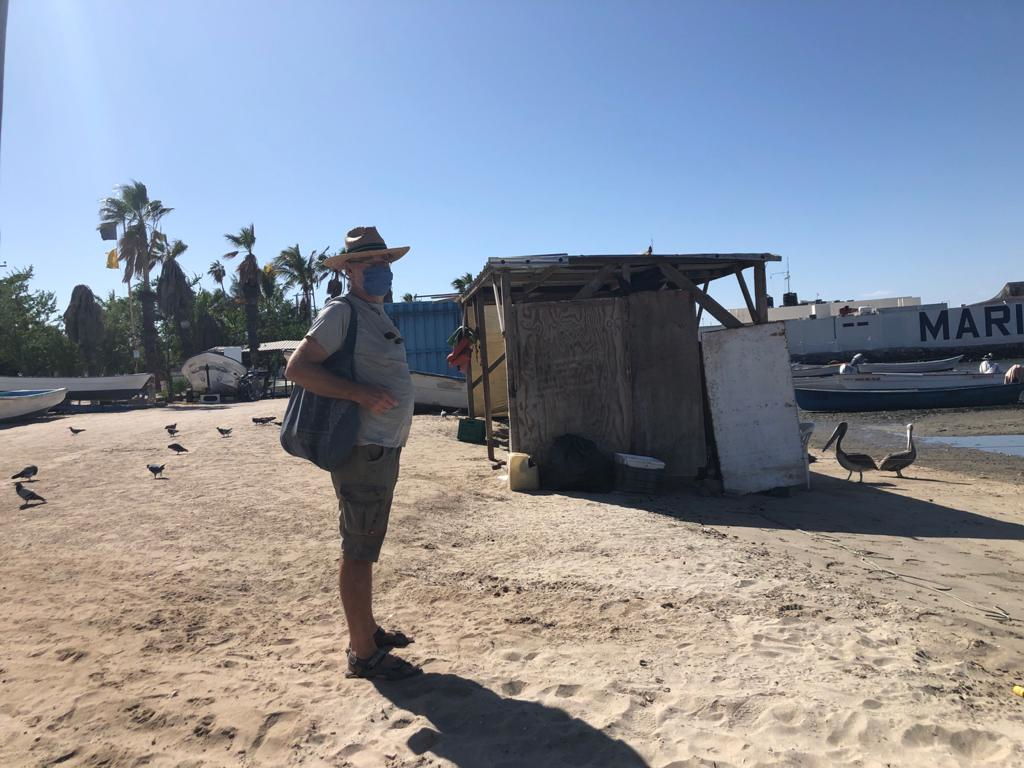

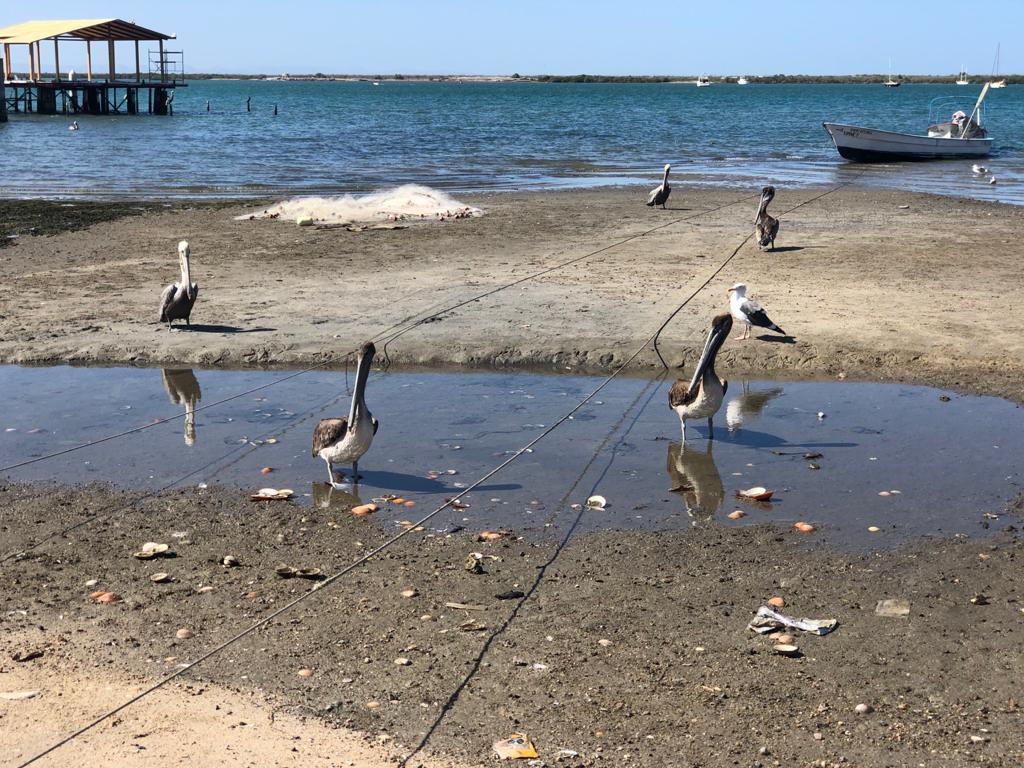
We weighed anchor from the bay in La Paz at the end of October and I experienced the delight of being back on the water after months of city life in the UK. The conditions were ideal: sunny, a fresh breeze, a gentle swell from the previous night’s storm and a cloudless blue sky. We were heading for the delightfully named Balandra Bay which sounded to me like a location straight out of a children’s story. The swell increased as we drew near to it, however and we were unable to anchor there because it would have been far too rolly. It looked stunningly beautiful, and as Paul has been there several times he knows there is a sea lion colony there. We hoped to be able to stop there on our return journey.
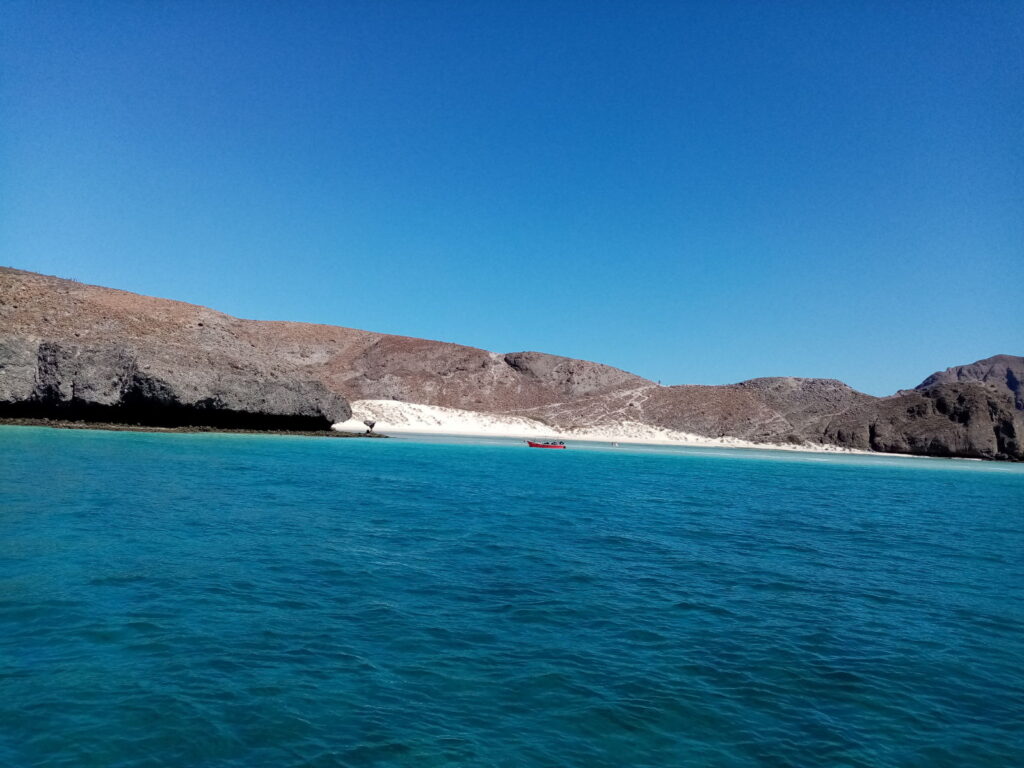
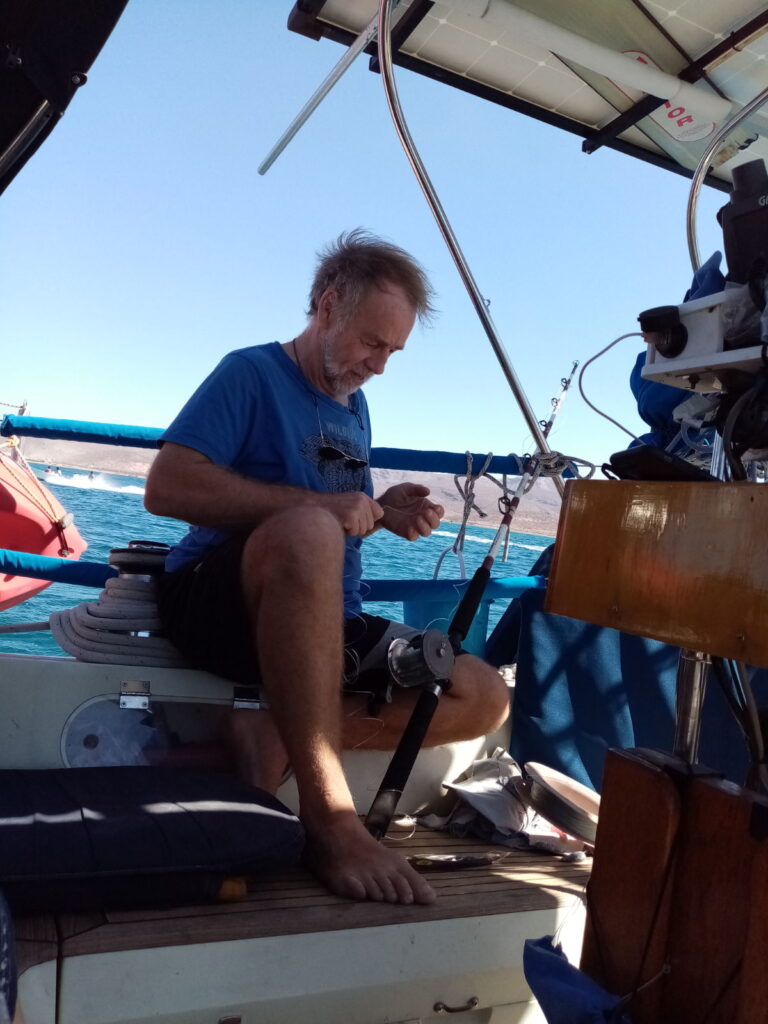
The main event of this passage was Paul’s successful attempt to catch his dinner. It’s still a fairly rare occurrence but he does seem to be getting the hang of it now 😉 .
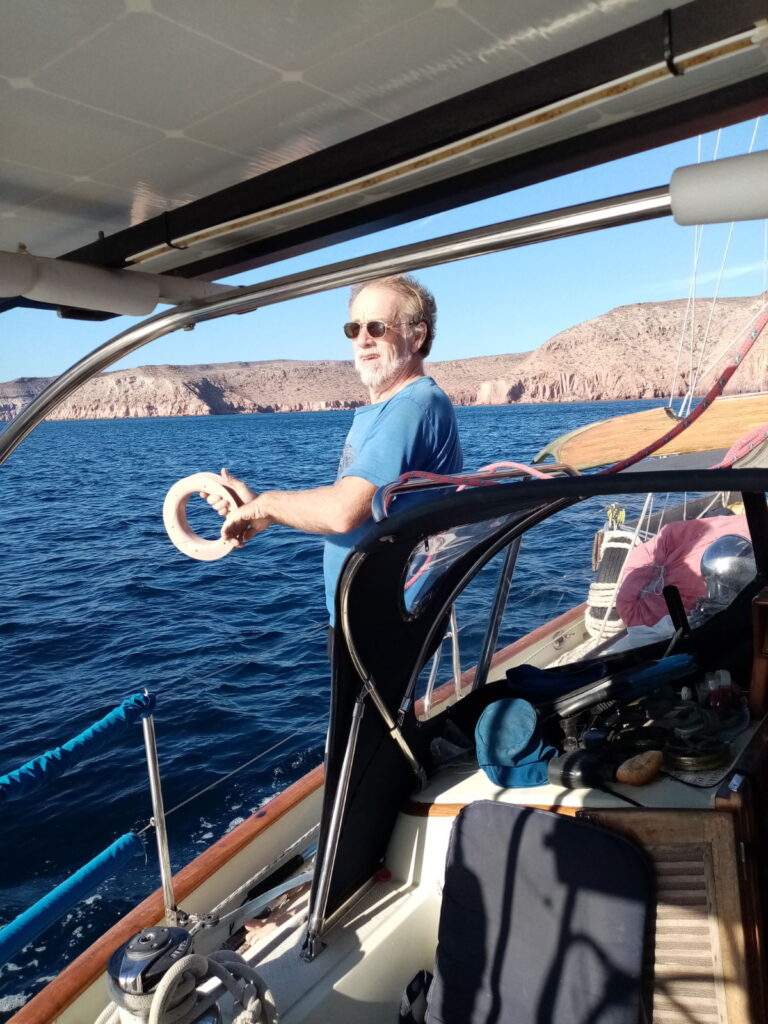
We anchored at 4pm in Partida Cove. The water was beautifully clean and clear. I was delighted to see turtles popping their leathery necks up, and it’s always entertaining to watch the diving antics of the pelicans. We had one fishing boat as a neighbour when we dropped anchor but a bit later a large catamaran and a few yachts arrived. Soon, the noise of family chatter, children’s shrieks and music broke the silence but not in too obtrusive a way. Just before sunset we dinghied near to the shore to check out the pelicans diving for their evening meal. Some of them came close enough for me to see the bottom of their feet as they soared down to their prey. One of the boats had released a drone to capture the scenes from above and I wondered what the pelicans made of the strange, noisy bird in their air space.
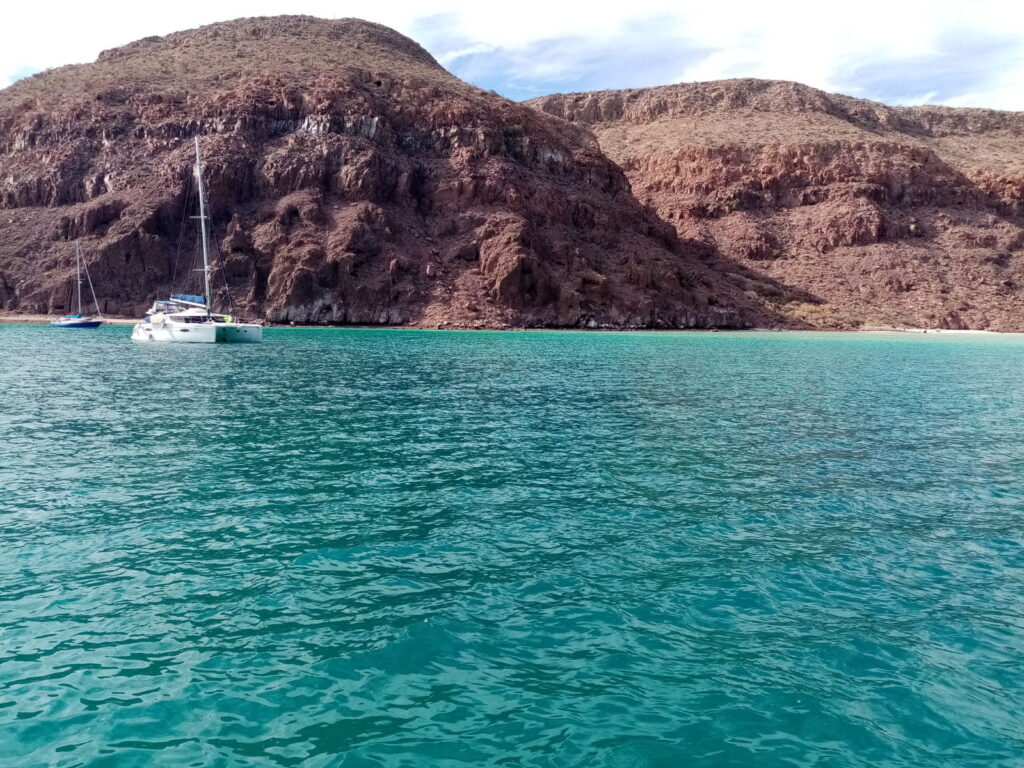

We stayed another day at Partida. The weather was perfect, and I had quickly got used to being without the internet. In fact, I found it emancipating to not have all the negative bulletins and news rolling in, both verbally and through social media. Such information saturation tends to predispose you to worry and anxiety I think. Out on the water, we were literally and emotionally removed from it all. Also, there was no need to wear masks as we were naturally socially distanced from people. We felt free to merely appreciate the beauty of the sights and sounds of the scenes around us.
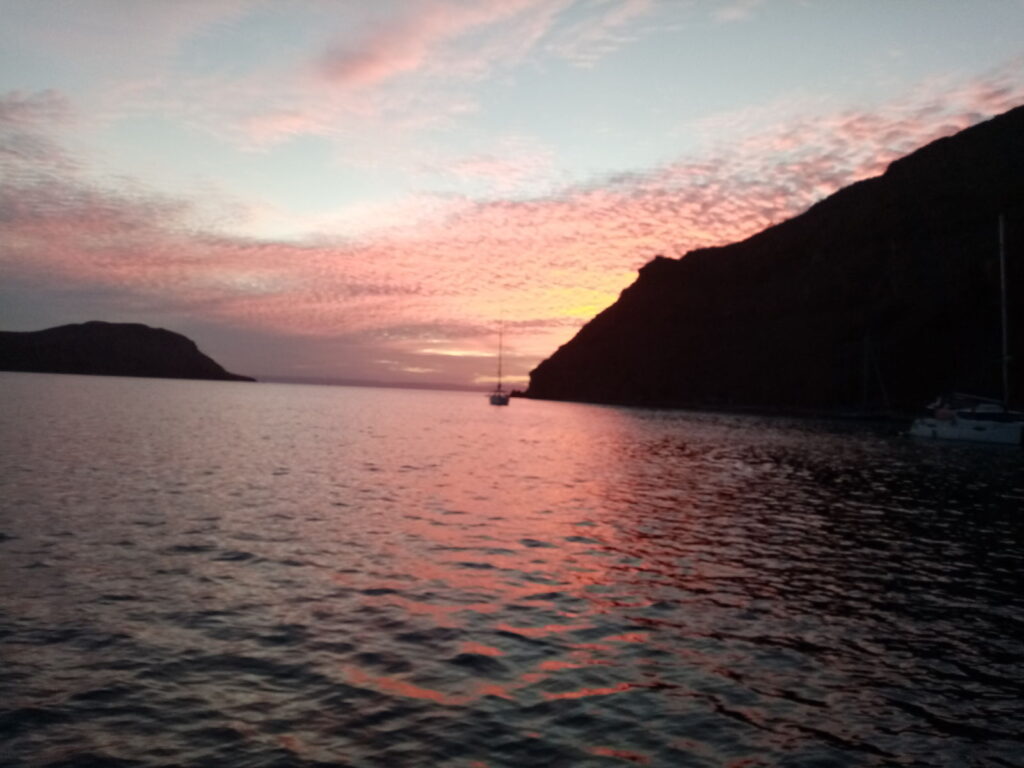
One of those sights was the seasonal fishing village on the shore. The tide was so low that we were able to get out of the dinghy and pull it quite a distance to the beach. In the clear shallows we spotted more turtles, manta rays and the ubiquitous tiger (black and yellow-striped Nemo) fish. The village was deserted, either through Covid restrictions or being off season, so we were able to amble freely around the wooden structures which reminded me of allotment sheds. It’s odd how a few deserted, padlocked huts and shacks, with their outside chairs and fish gutting tables left in situ, convey something of an eerie atmosphere, especially as the ground was littered with skulls and bones and fish skeletons…or maybe I just had Halloween on my mind. I hadn’t taken my phone to capture the images unfortunately. At least there were no plastic bottles and empty cans littering the area, and we ended the afternoon with a cooling swim and snorkel.
Next morning, I was up early, sitting in the cockpit watching sea turtles. Their heads pop up periscope-like, revealing their striking green and yellow necks and coal black eyes for a brief moment before they sink out of sight below the surface. Our destination that day was just a short hop away to Isla Espiritu Santo and we were on our way there by 10 enjoying the mid-morning sun and sea breeze. Candeleros (Candlestick) Cove had been closed to visitors for a few weeks when Covid struck but Paul had been there with Jim just before the pandemic and latterly with Arturo as restrictions were relaxing. During their visit in August they had been the only two there and had seen goats all over the island. We joined several tourist boats as well as catamarans and yachts when we anchored early in the afternoon. Umbrellas on the beach were sheltering picnickers, and dinghies were frequently ferrying people back and forth. The goats, who had probably made the most of having the place to themselves when visitors were banned must have retreated back into the hinterland. The striking rose-pink rock formations and tall mountains surrounding the long sandy beach made an attractive vista from the boat, and didn’t disappoint once ashore.
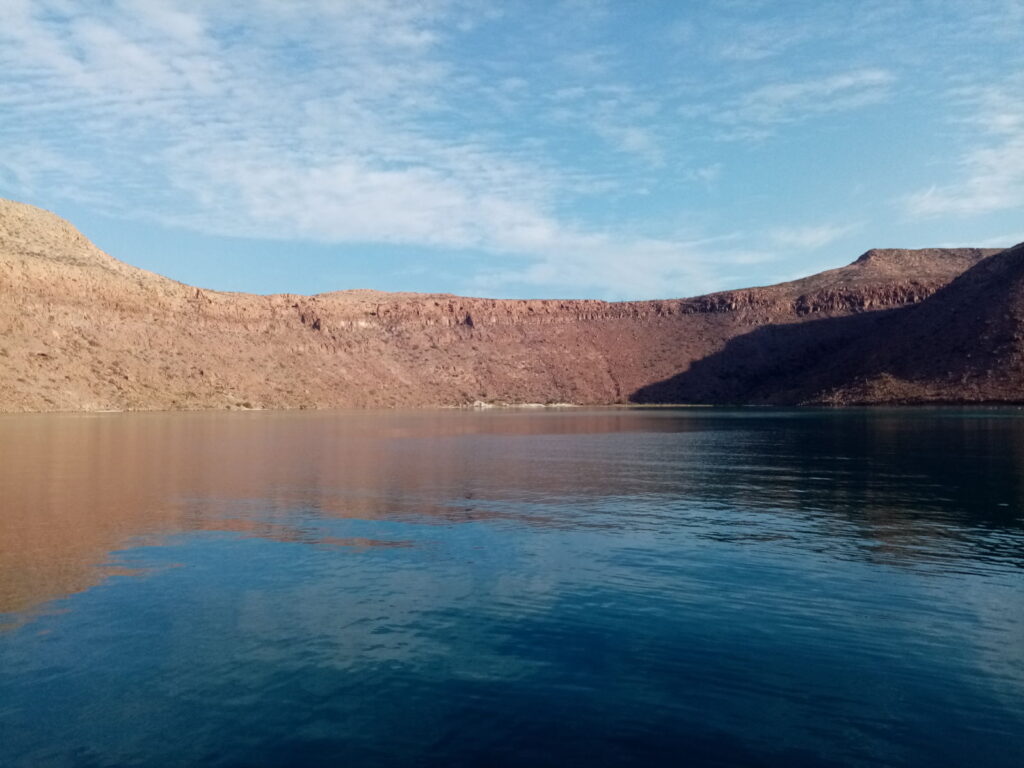
We made straight for the trail behind the beach, passing this huge chair-shaped rock which has no doubt hosted hundreds of bottoms before ours.
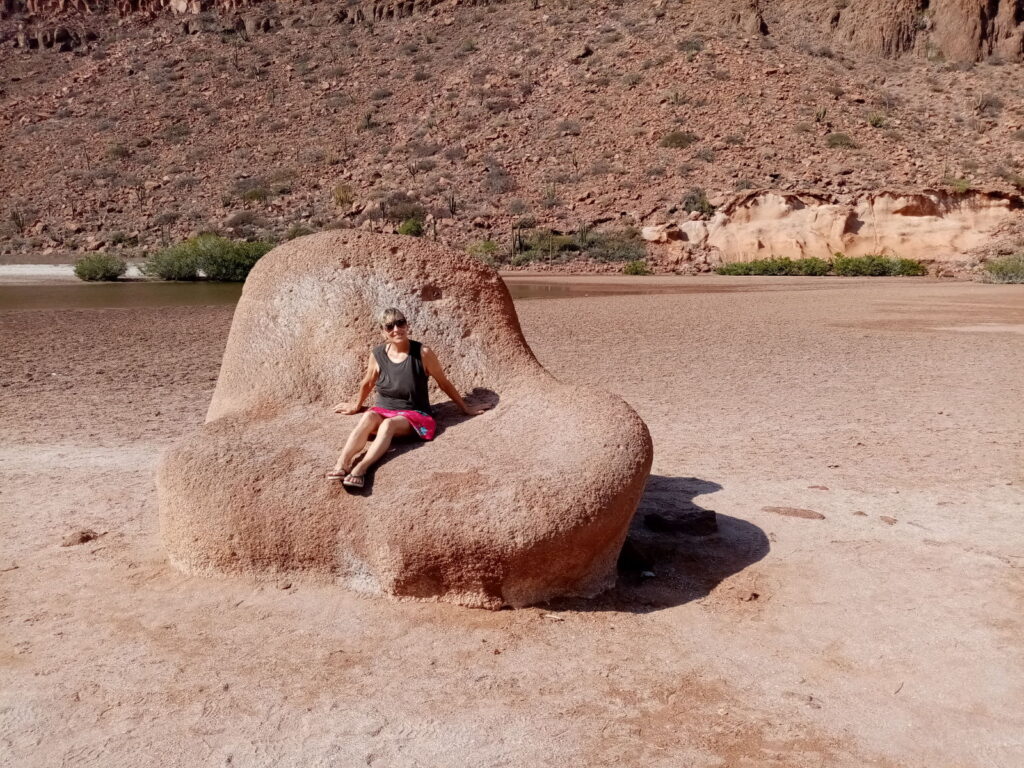
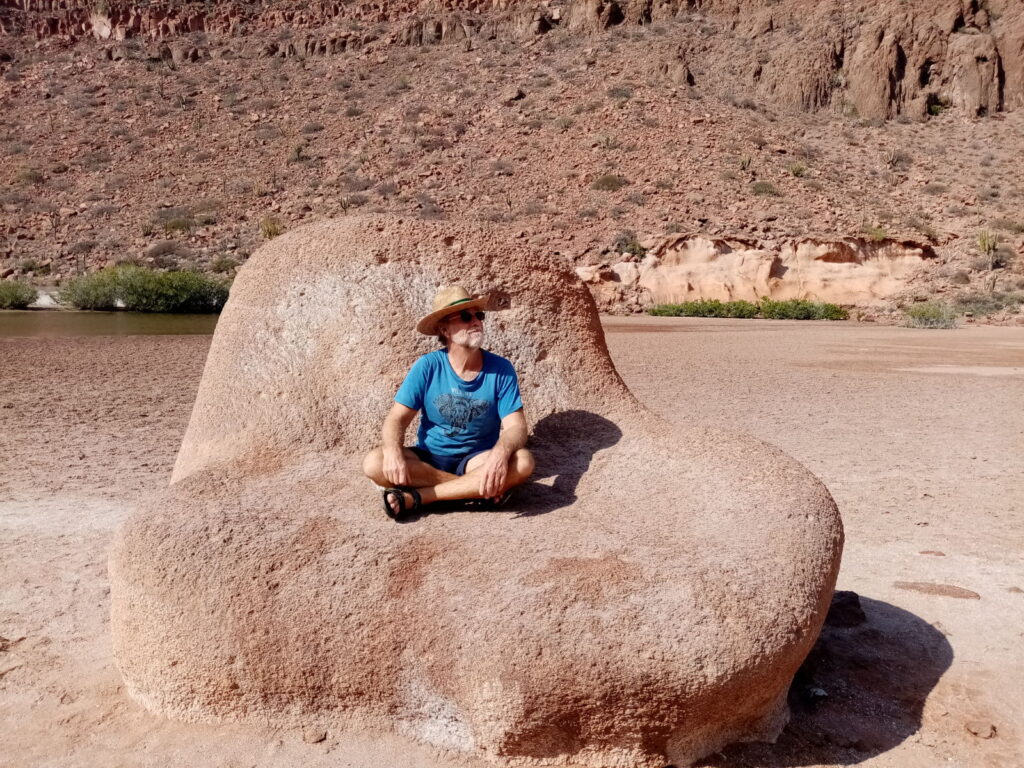
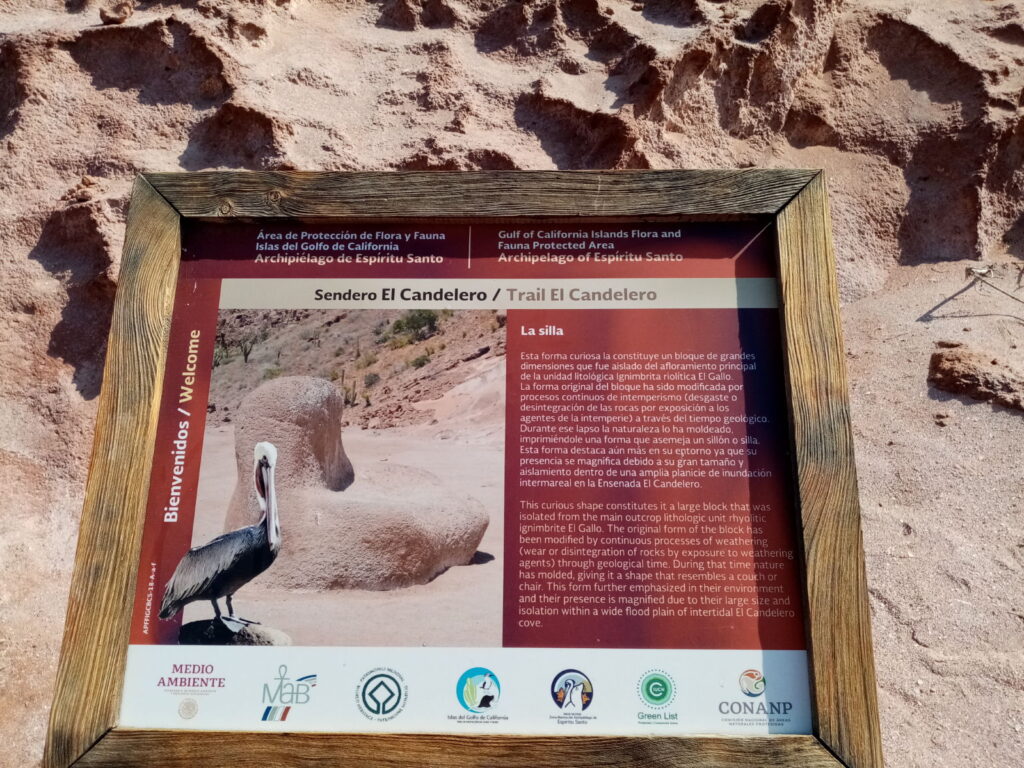
It was blisteringly hot by then but luckily it wasn’t too arduous a walk, although there was a bit of climbing involved in some places – not the easiest thing to do in flip-flops. The landscape, with its stereotypical cactus plants, boulders and arid scrubland couldn’t have been more Mexican. I was thrilled by it. Hearing movement near a tree, I could just make out the distinctive horns of a goat. Sadly, it remained behind the tree despite our attempts to stay still and quiet, so we left it in peace and walked on. Ahead, we saw a group of people higher up the trail. The shrieks of delight we could hear turned out to be due to the fact that buckets of water were being poured over the heads of three young ladies. They were gathered round a square hole and an older man – an American tourist we learned – was drawing water from it to pour over the heads of the willing volunteers while his wife looked on with glee. They introduced themselves, telling us they were on vacation from Santa Rosa, north of San Francisco and invited us to join their ‘baptism’ fun. We politely declined, despite assurances that it was nice fresh, cold water. Later, I read in our pilot book that it’s an historic well but is usually disused and dry now, so perhaps they brought water ashore to pour in there. The girls were impressed anyway. We didn’t go much further because Paul couldn’t remember the way he had walked before, and the heat was beginning to get to me. We headed back to immerse ourselves in the welcoming cool of the sea.
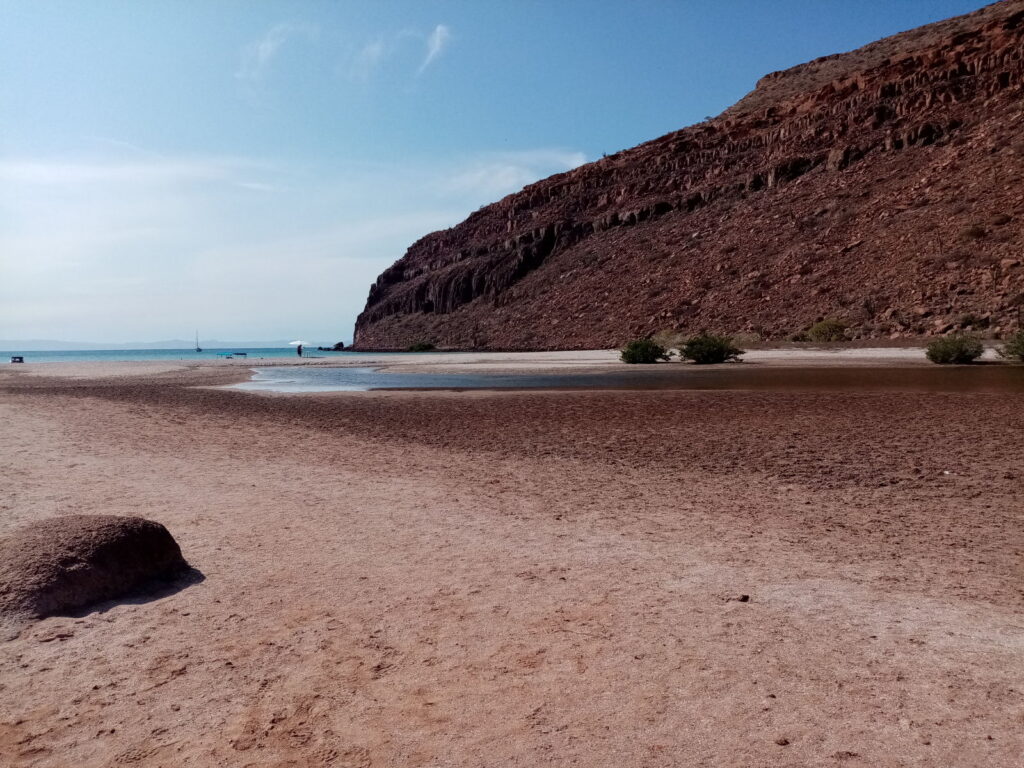
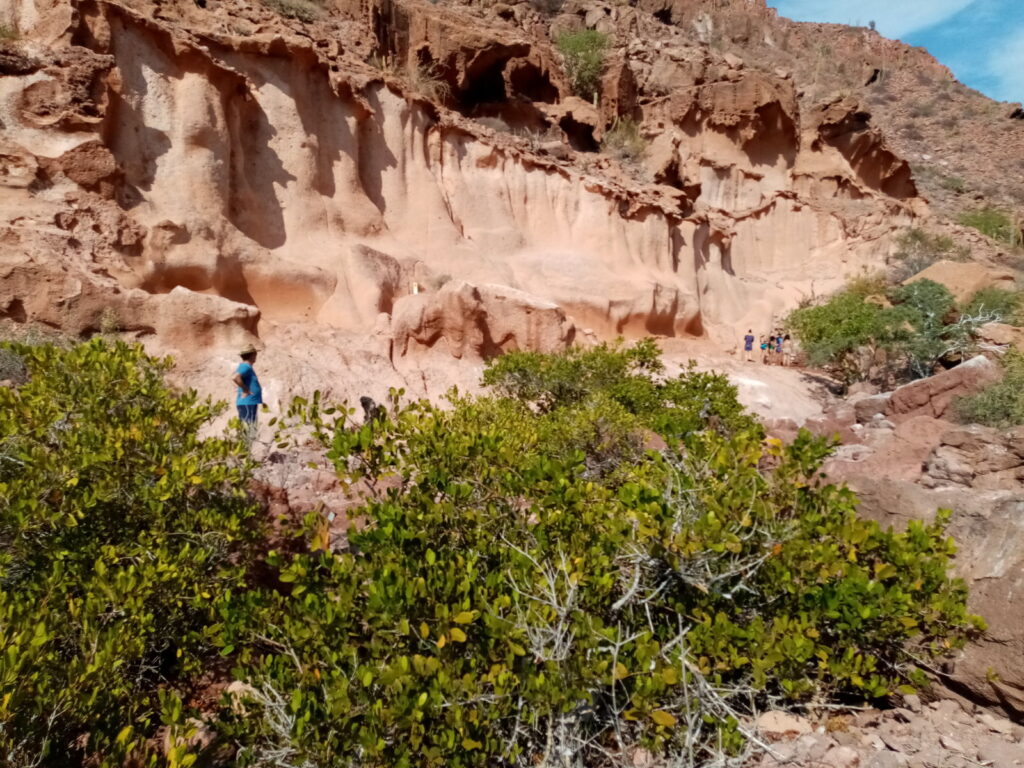
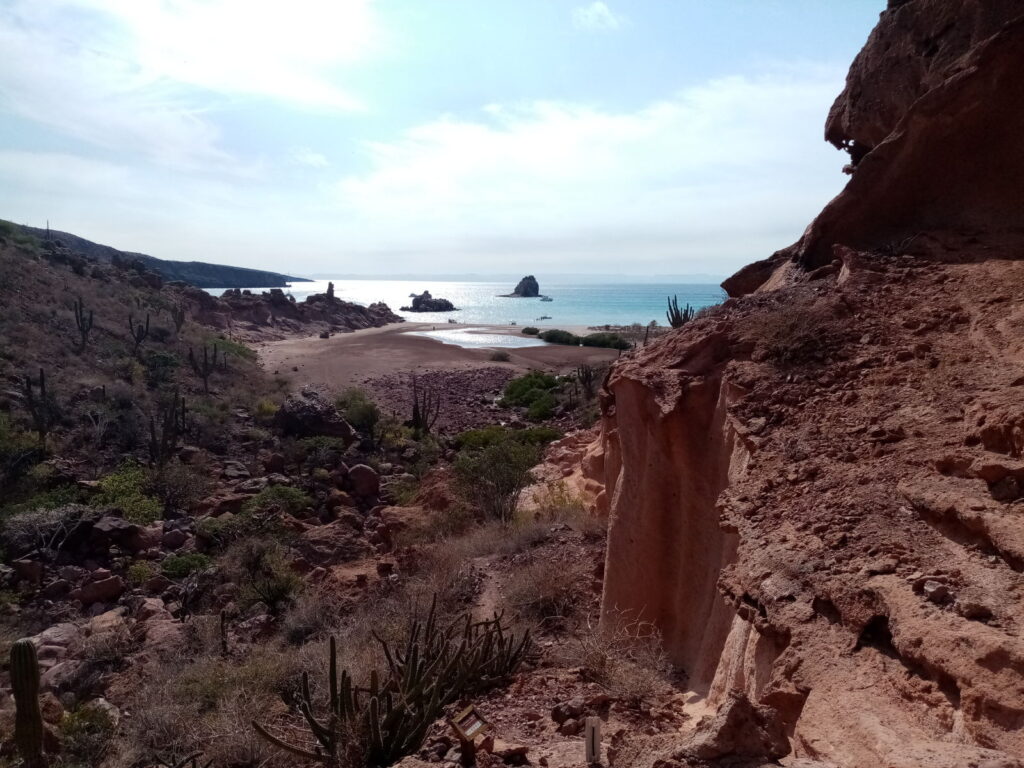
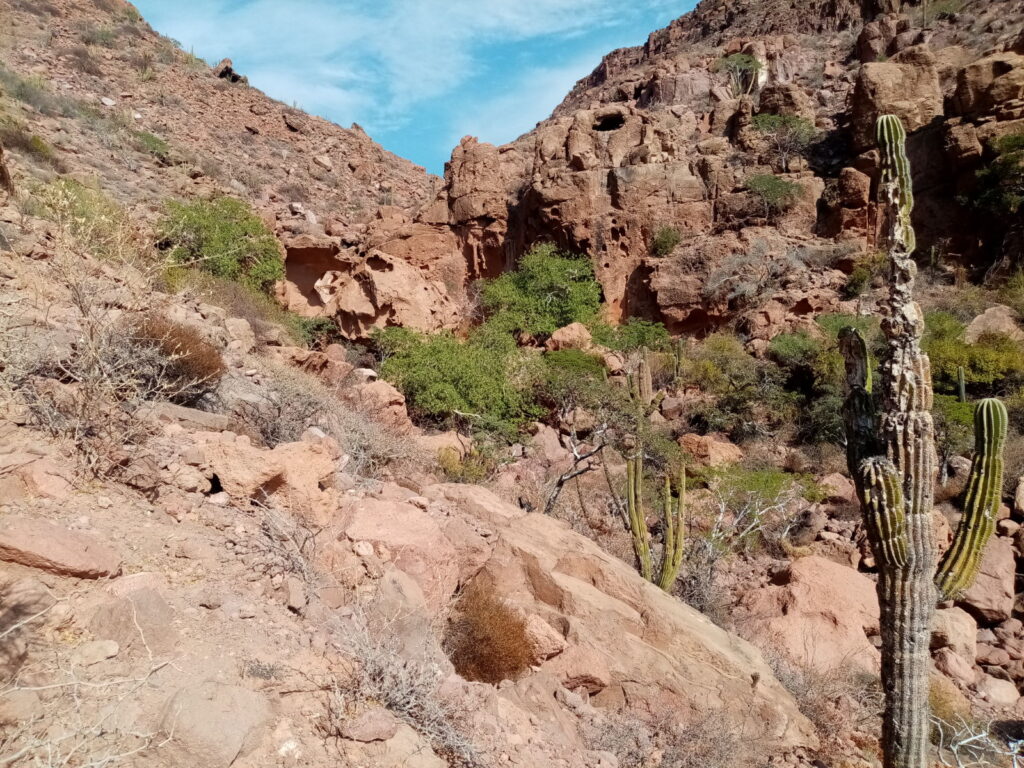
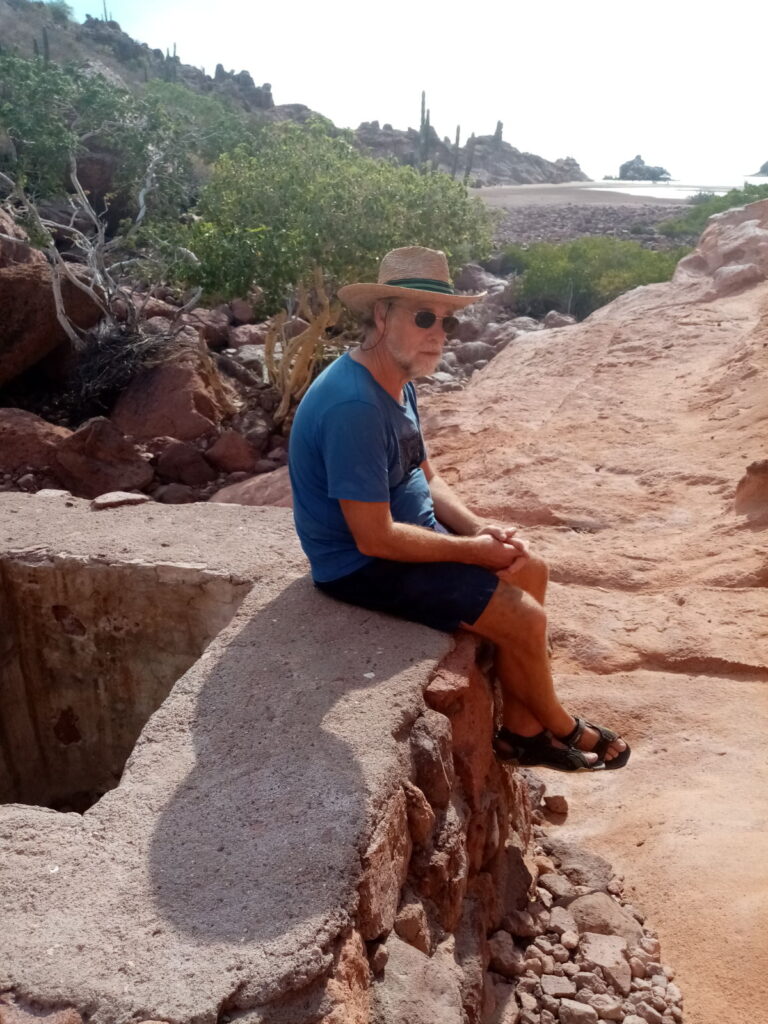
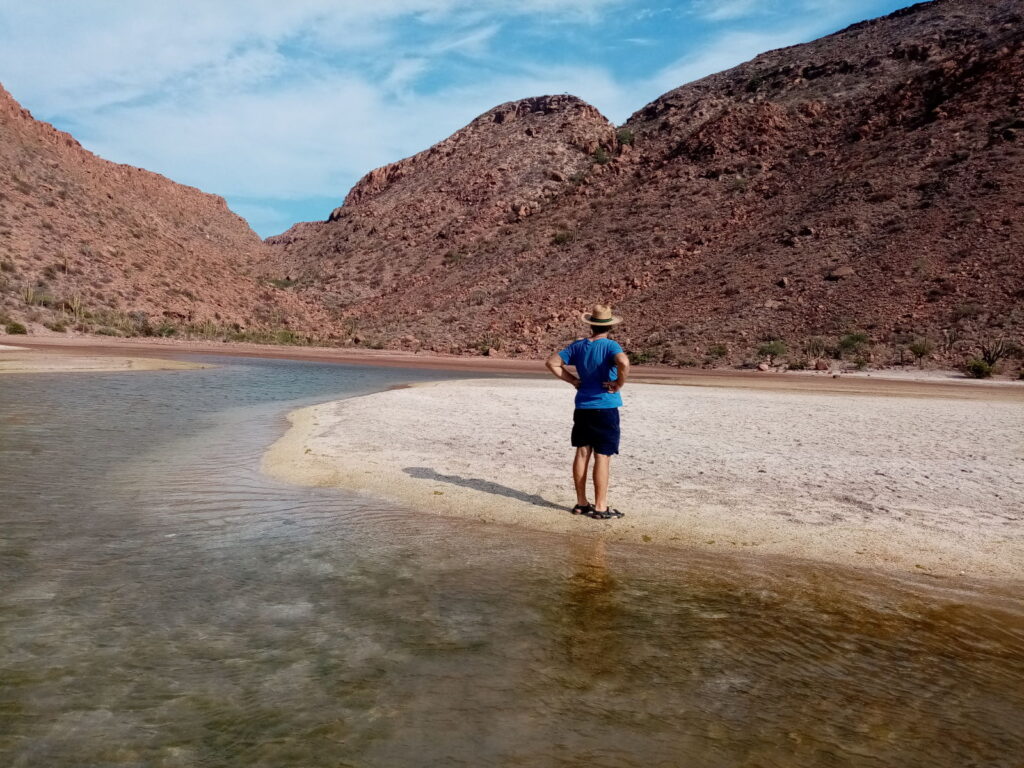
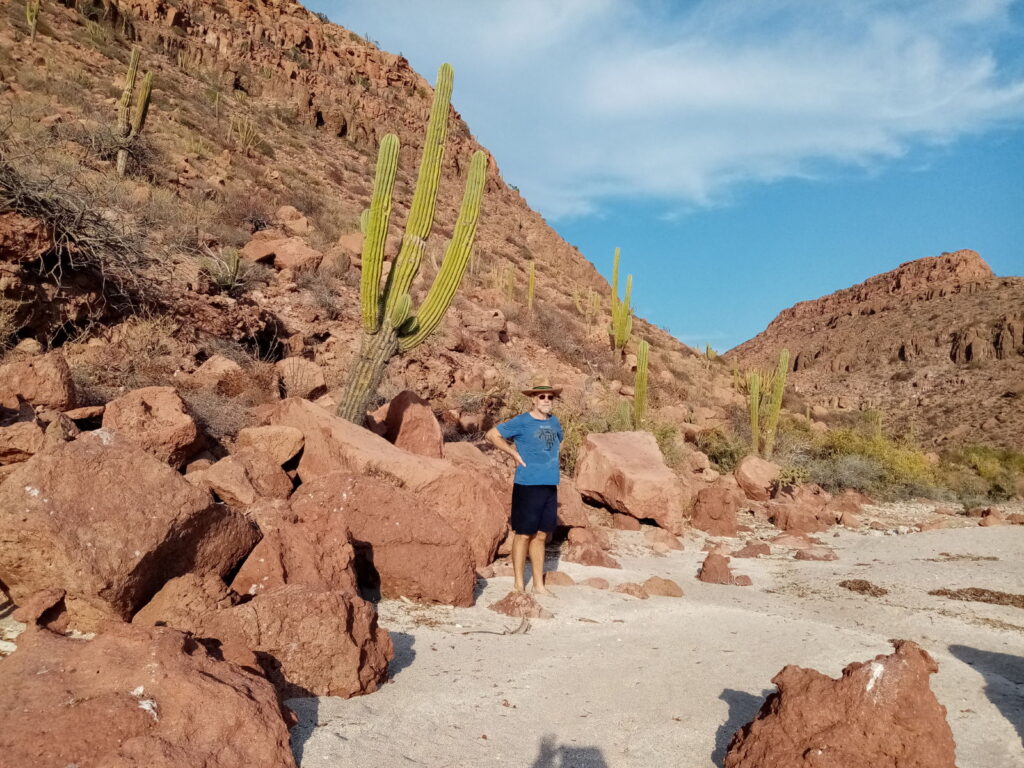
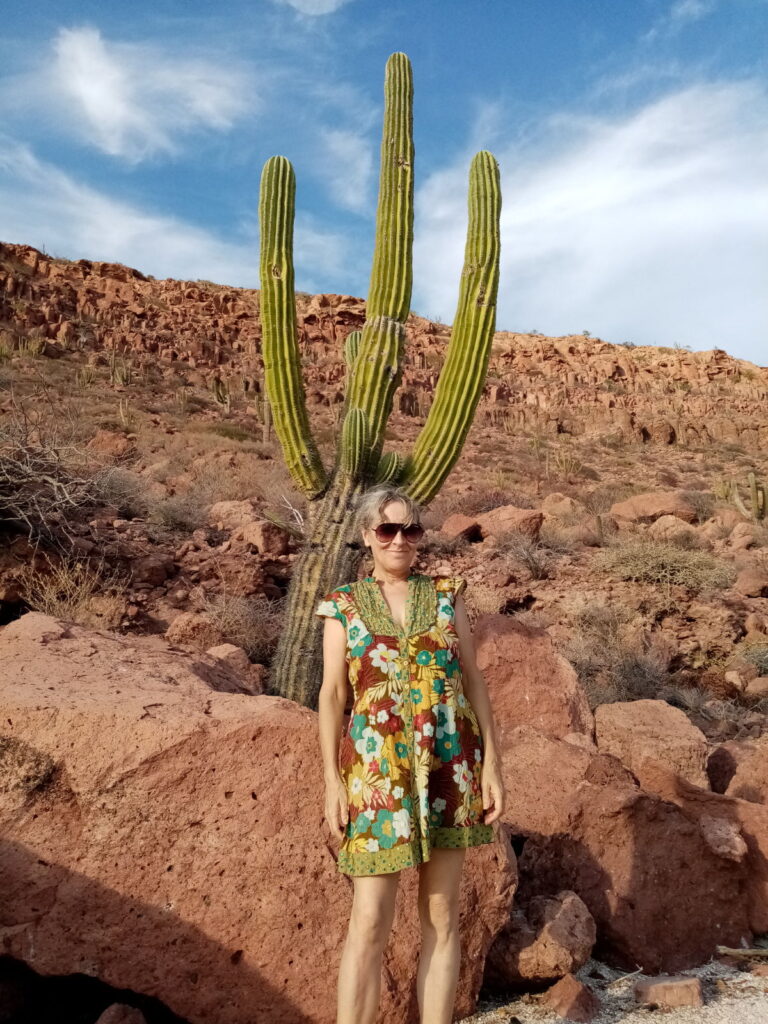
We stayed another full day at anchor. Sunday 1st November brought a stronger breeze which blew through the cabin as effectively as any air conditioning system. A tourist boat heralded its arrival at midday with the sound of loud dance music. We could see the DJ at a mixing desk on the top deck of the super yacht and the music got louder according to the direction the boat was swinging. They didn’t hang around long enough to be too intrusive, though.
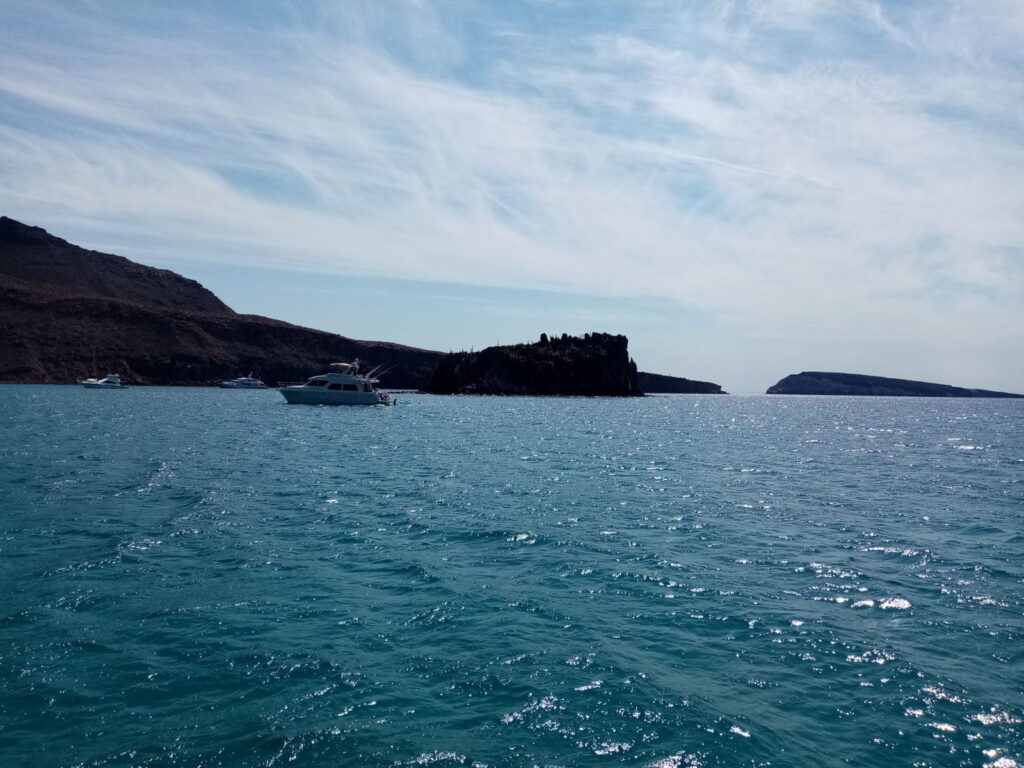
I was keen to do more of the walk we had cut short the day before so we dinghied over to the beach in the afternoon. It was a bit cooler, and I was better prepared for the rocky terrain in rubber soled shoes. The ubiquitous cactus plants are so like the images from the cartoons and comic strips I enjoyed in my 60s and 70s childhood. I haven’t got tired of marvelling at the size of them yet.
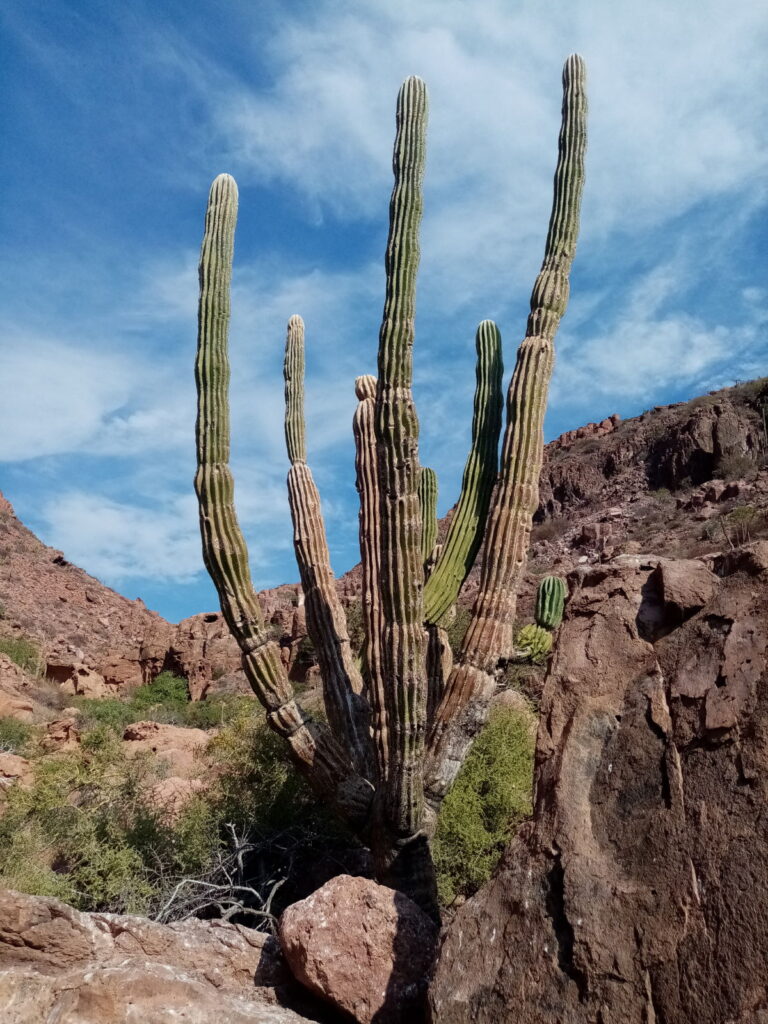
Huge birds soared over our heads as we ascended the hill, lizards of all sizes scurried away at our approach and we passed caves and caverns and dry, spindly trees and bushes. We hadn’t gone very much further than the previous day when we came to another sudden stop. It was beginning to look like we would require crampons and ropes if we wanted to get any further. Paul still couldn’t remember the way he had gone on a previous visit, and since it was beginning to get hot again, I was content to take a few more pictures and head back to the beach.
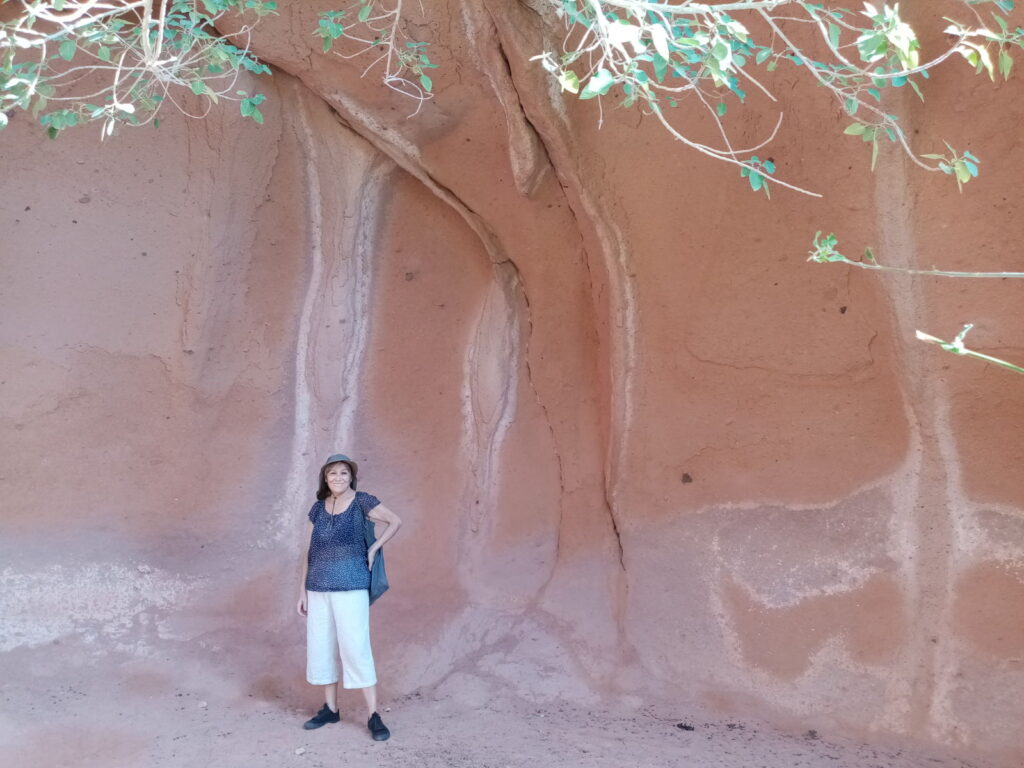
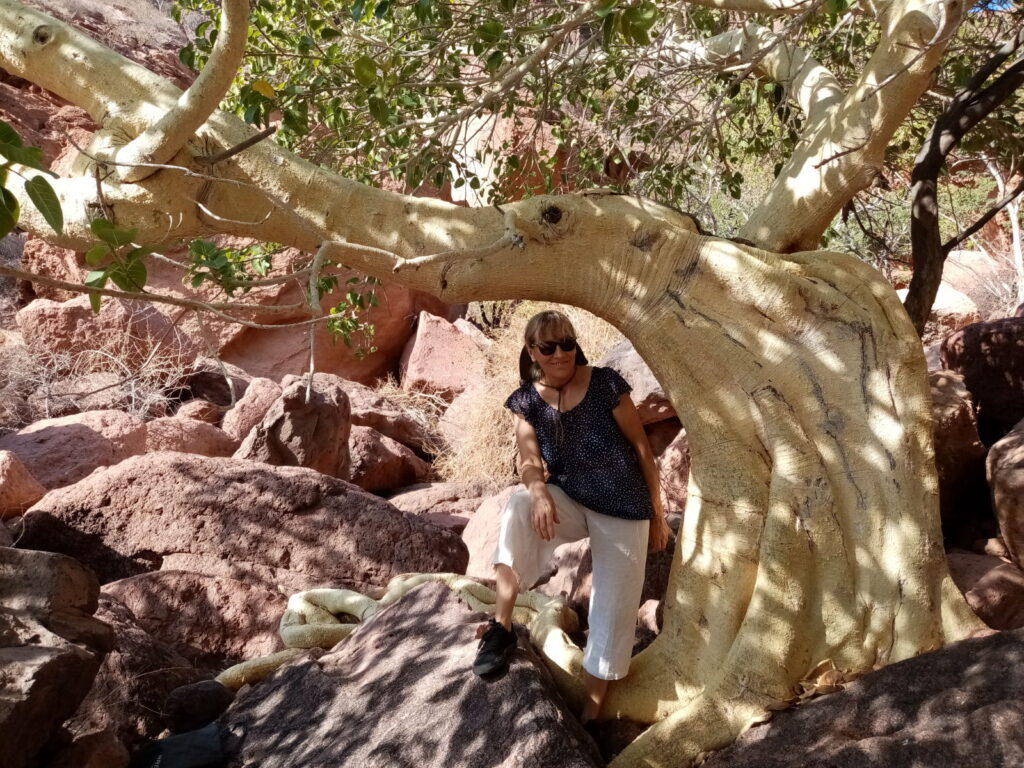
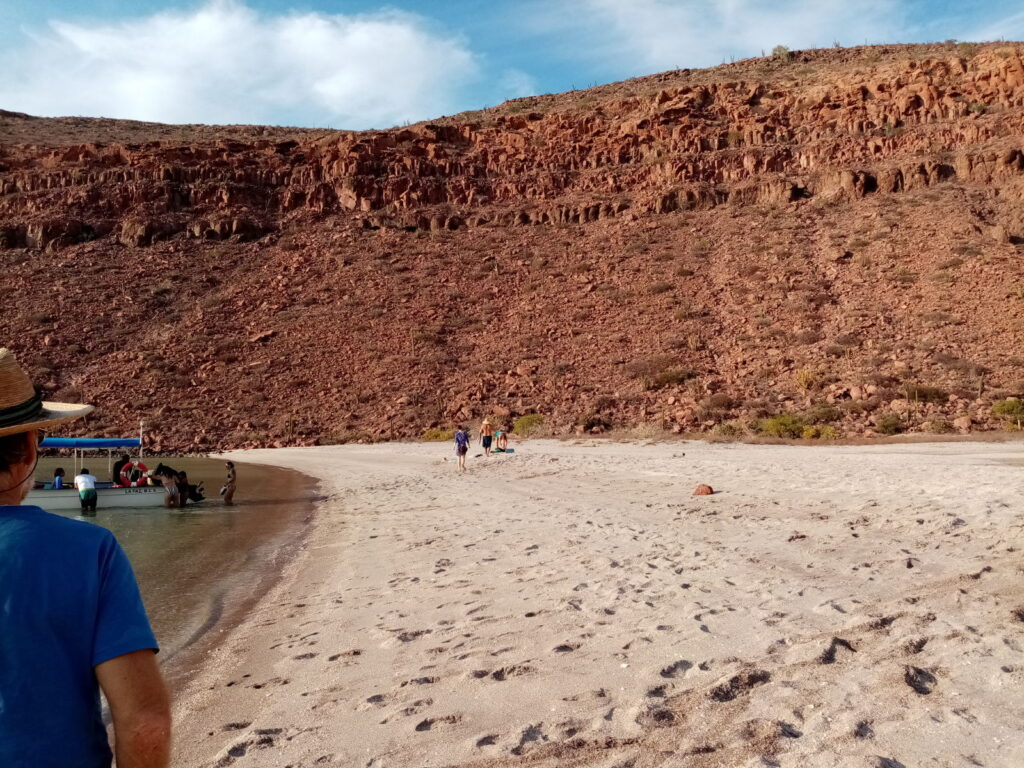
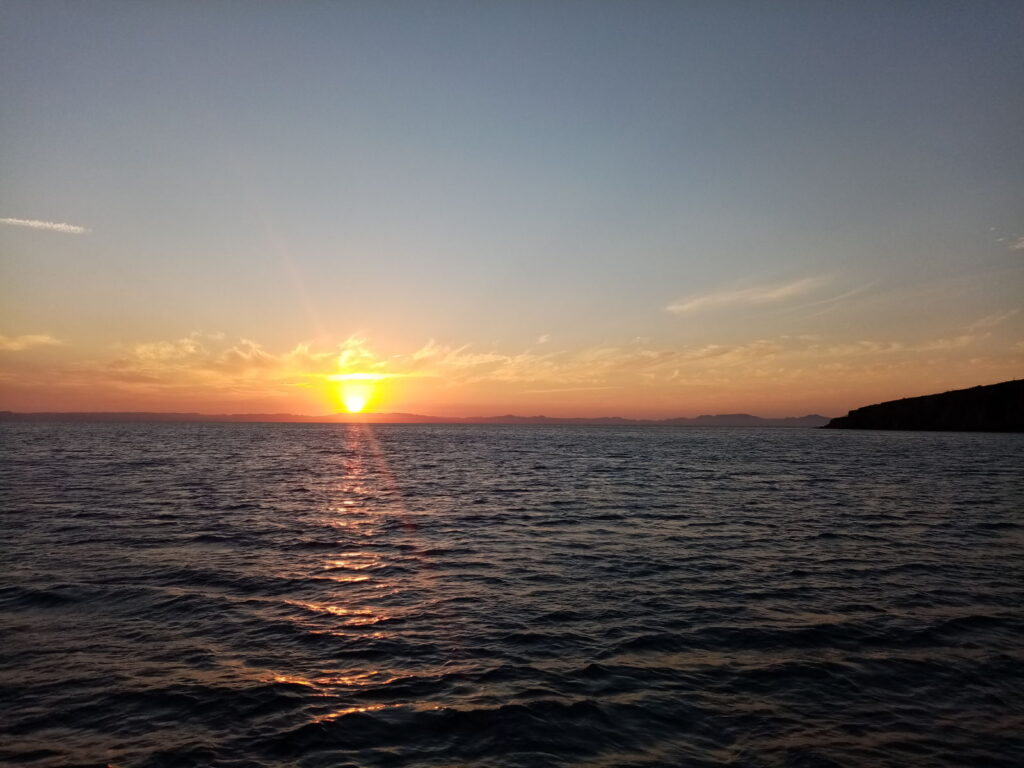
We were able to visit Balandra Bay on our return journey. The wind had allowed us to sail some of the way and we arrived there mid-afternoon, pleased to discover that it was calm enough to anchor without the swell that had been there the week before. Balandra Bay is famous for its mushroom-shaped rock. Tourist boats ferry people there so they can pose in front of it, especially at sunset. It does resemble a mushroom but we had noticed that the coastline has several of these geographical formations along the peninsula. This one must be profitable in terms of distance and provides an ‘Instagram-friendly’ photo opportunity due to there being a convenient signal for phones. So much so that it has been repaired from several ‘topples’ and now sports a vandal-proof rebar framework and tinted cement! It seemed appropriate to capture the image for our own album. Disappointingly, we didn’t see any sea lions this time either. Pics below of the rock and beach at Balandra.
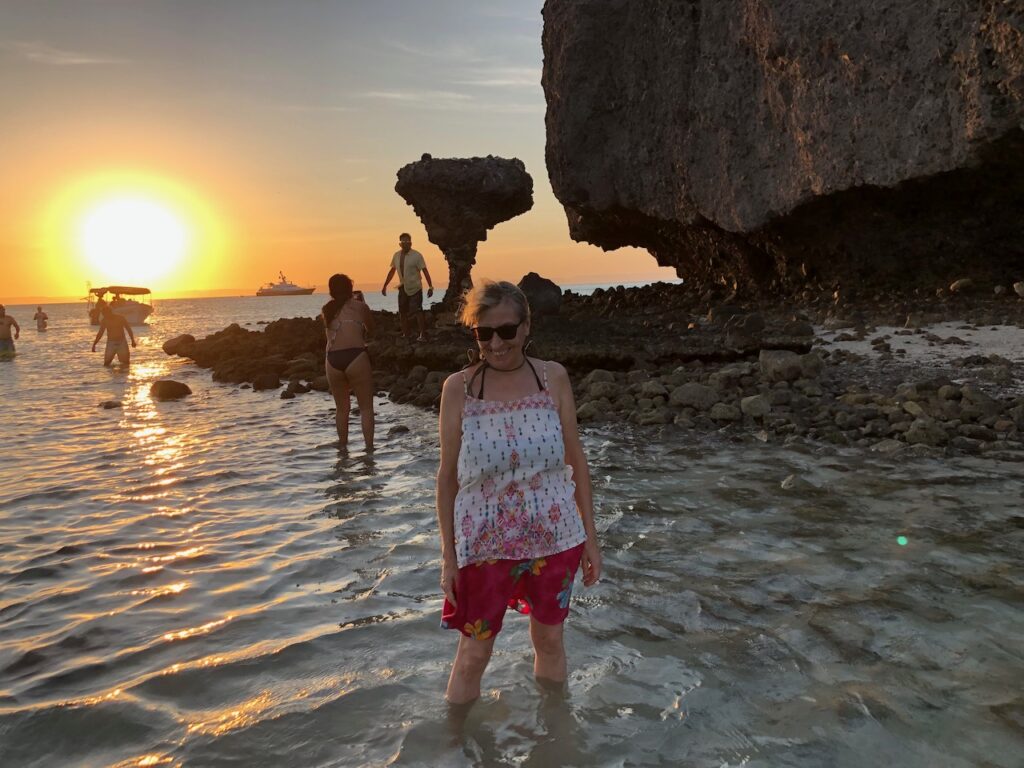
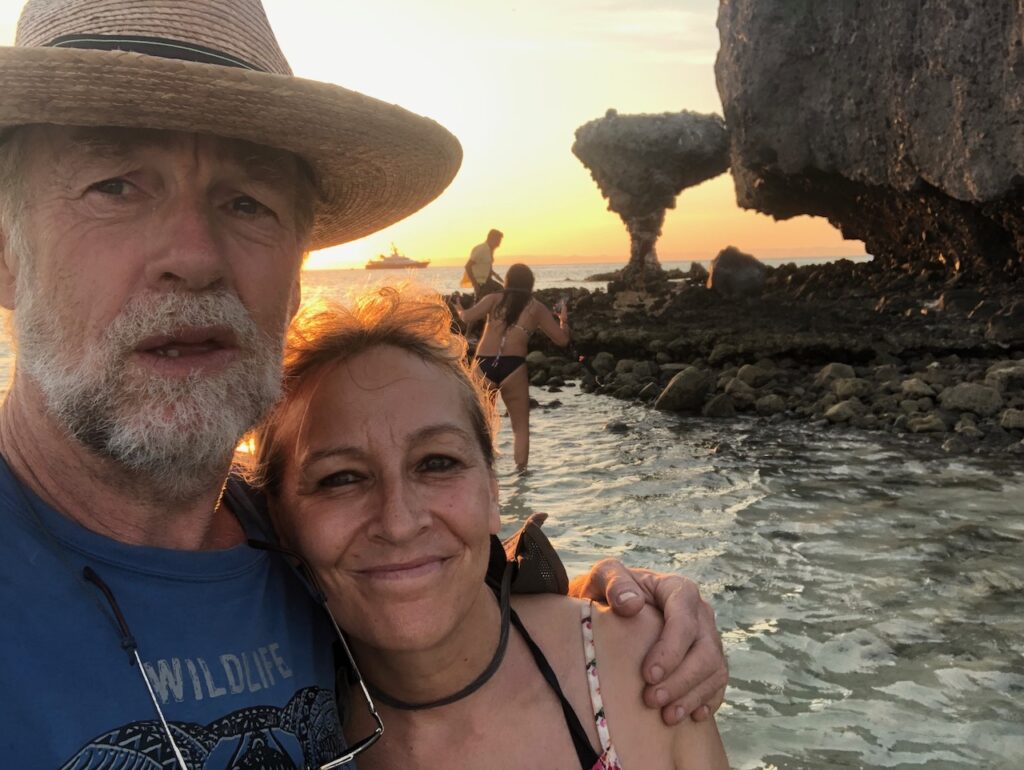
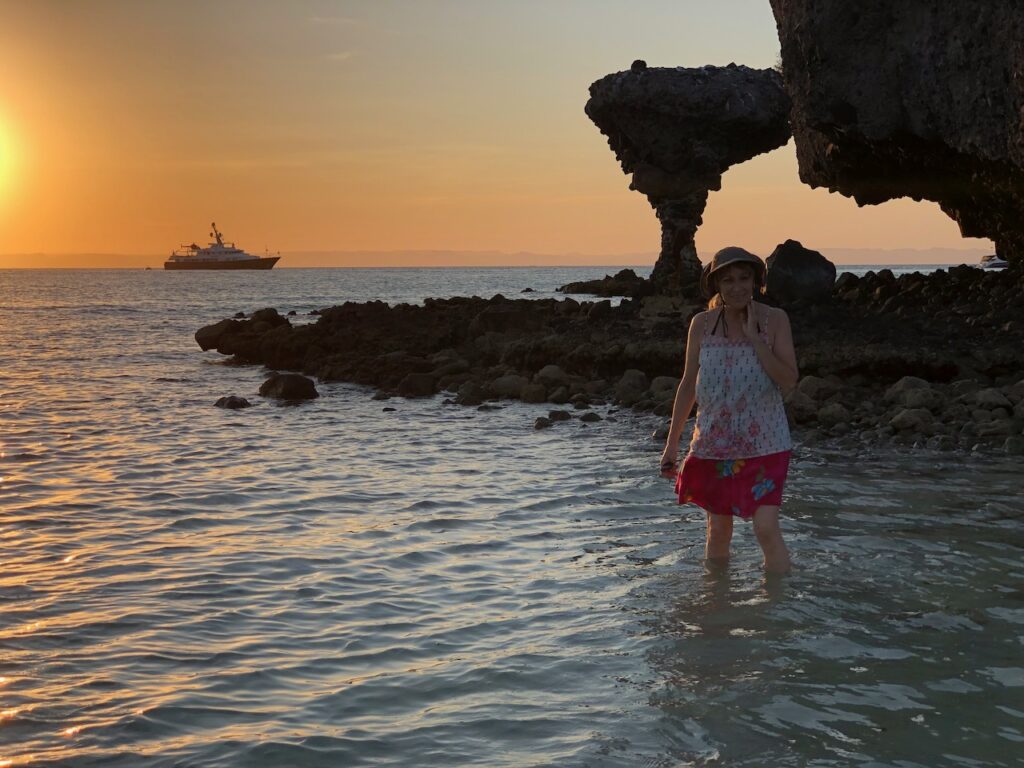
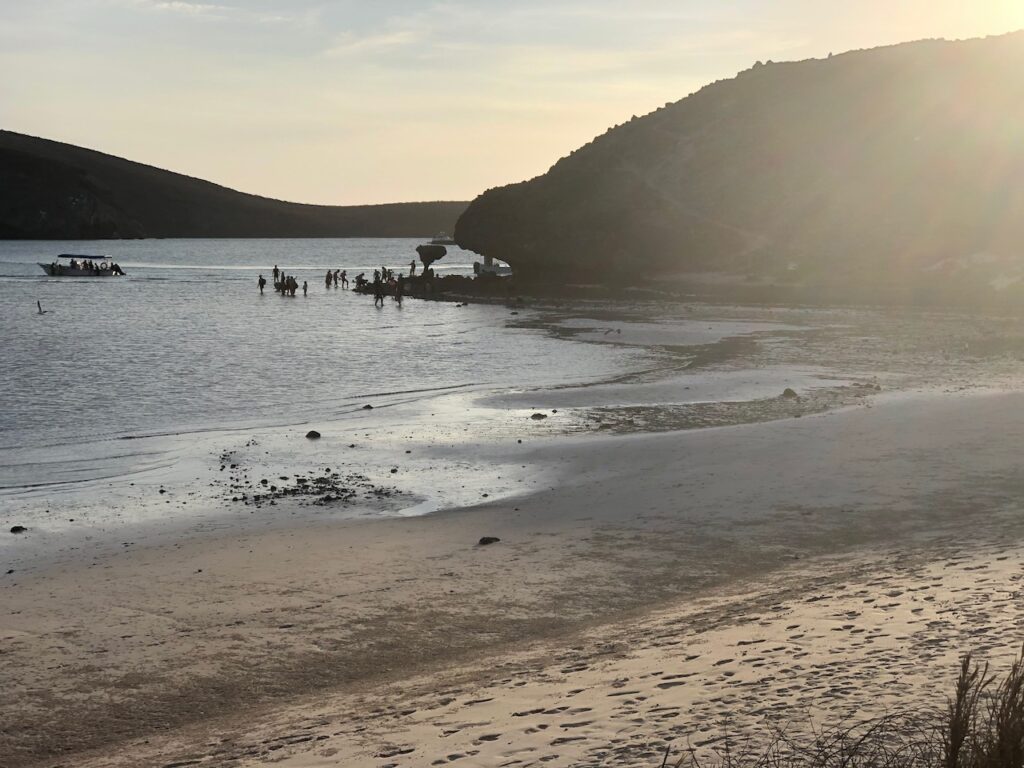
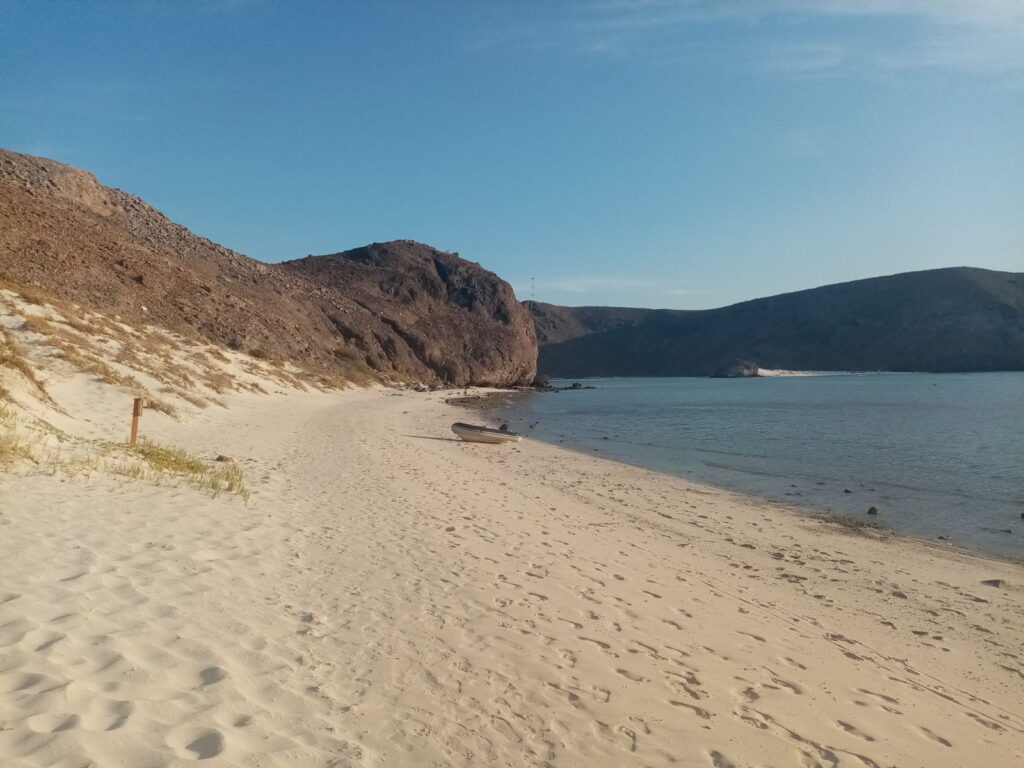
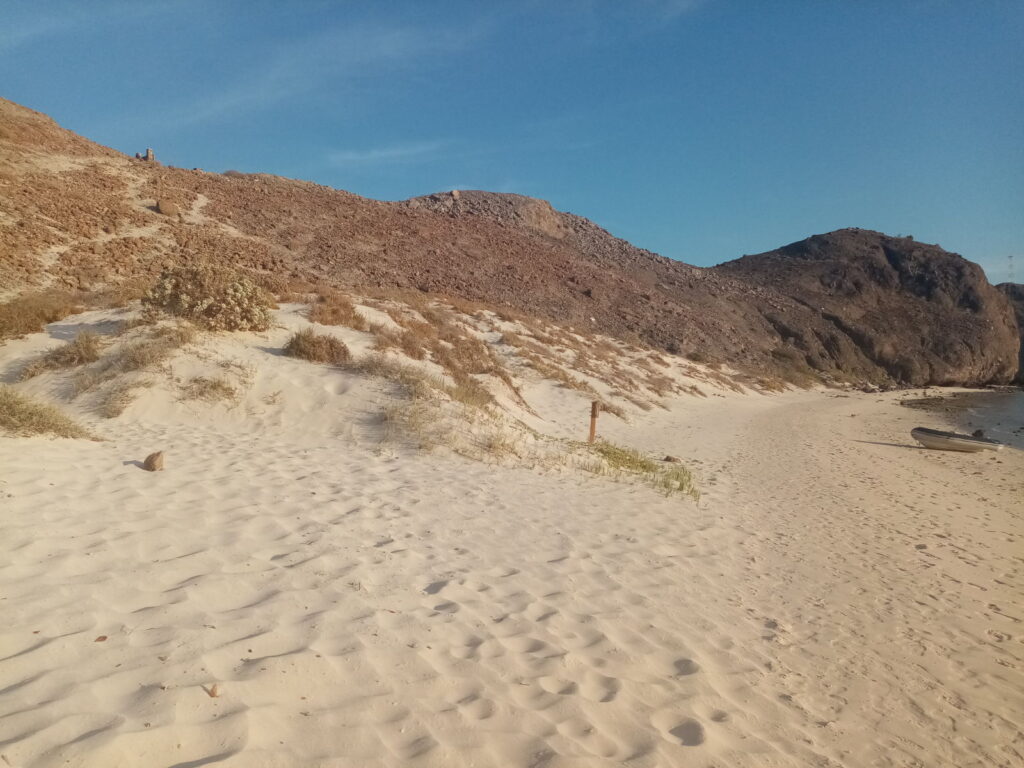
We made it back to La Paz to catch all the excitement of the results coming in for the US election. It was both enjoyable and fascinating, and with the best of all results, so it was well worth returning to signal range to watch that, and to catch up with friends and family. We were at anchor in the bay for just over a week and discovered that like many places around the world, restrictions were being tightened up in response to rising infection rates. One of these is to separate young and old shoppers in Chedraui supermarket. As I approached the entrance, I understood enough Spanish to realise I was being asked for my age. It must have perplexed the guy when I answered him in Italian, which is similar enough for him to understand I was telling him 58. Yes, I took two years off my age because I had a feeling 60 might be the cut off year (also, I couldn’t remember how to say 60). I felt sorry for him actually, having the job of asking everyone’s age and then allowing or refusing them entry accordingly. I was permitted to enter but Paul wasn’t, so I once again found myself in that supermarket with no bags and a certain amount of frustration about what items to get because I couldn’t consult with Paul. We tended to favour Soriana Supermarket after that. Below are pics taken in the Soriana car park showing what happens when a bike lock key has been left on the boat! Paul had to walk off to find a shop that sold hacksaws while I stayed by our bag-laden bikes. I hoped our sign language and halting Spanish had been enough to convince the security guard that we were the bikes’ owners as he watched Paul cut the chains to free them.
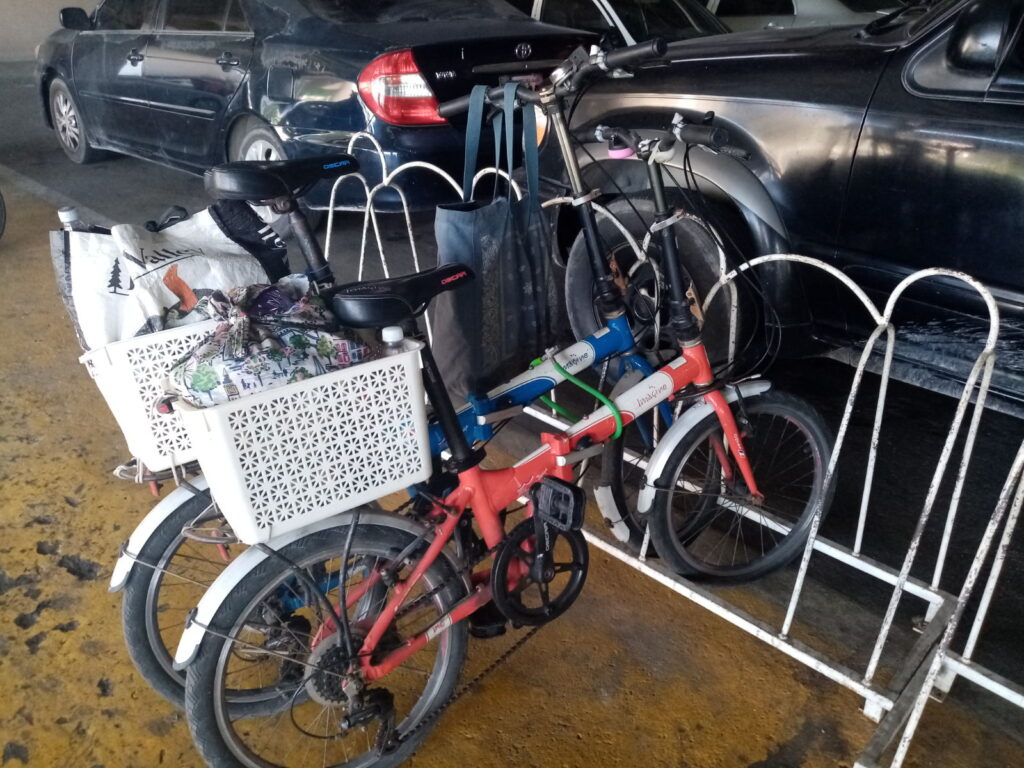
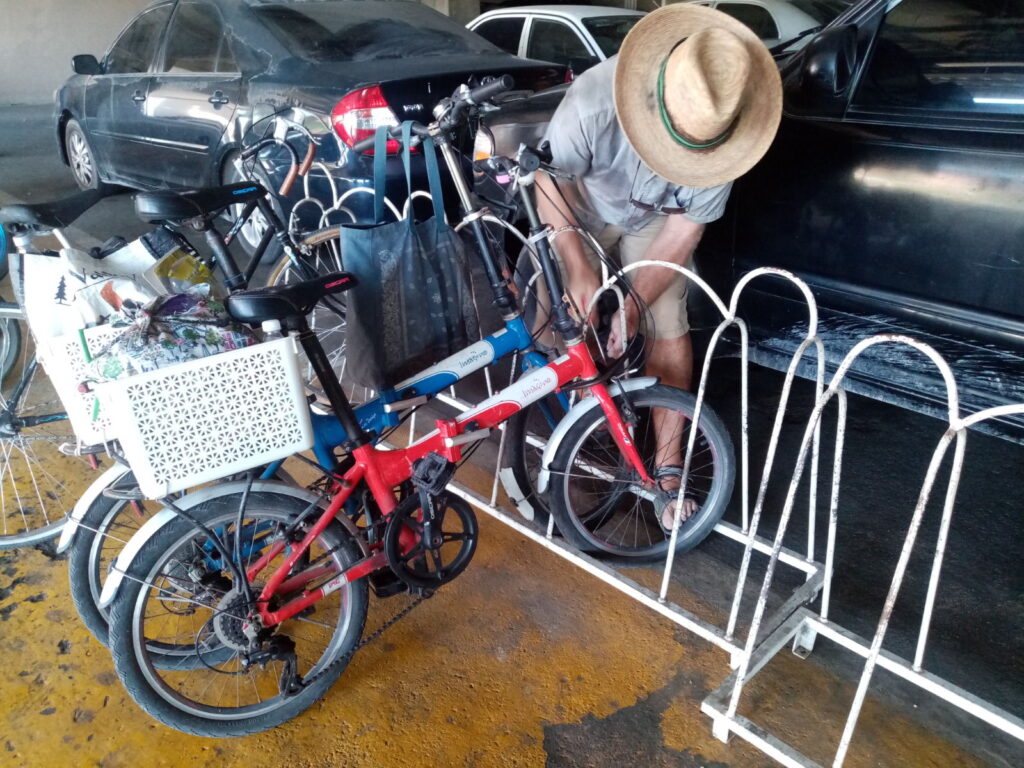
We had a pleasant, chilled out week back in La Paz, provisioning and preparing for our next Sea of Cortez excursion. It was good to see Arturo again and to meet Dirk and Silvia, who were anchored near to us in the bay and called over to say Hi. We met for a coffee on the Malecon to swap journey and places experiences – one of the many joys of sailing, or of travelling in general for that matter.
It became gradually cooler while we were there. So much so that we retrieved the duvet from its summer storage. It won’t get really cold here but the evenings now often require an extra layer or jacket. On Friday 13th November, the evening before we left, we met up with Arturo to have a meal on the Malecon. It was good to see that the already-struggling bars and restaurants hadn’t been subjected to more restrictions. The promenade itself has been limited to only being accessible during the week; at weekends people are only allowed on the far side of the road. This does tend to force people to converge on just one street but at least most are still wearing masks.
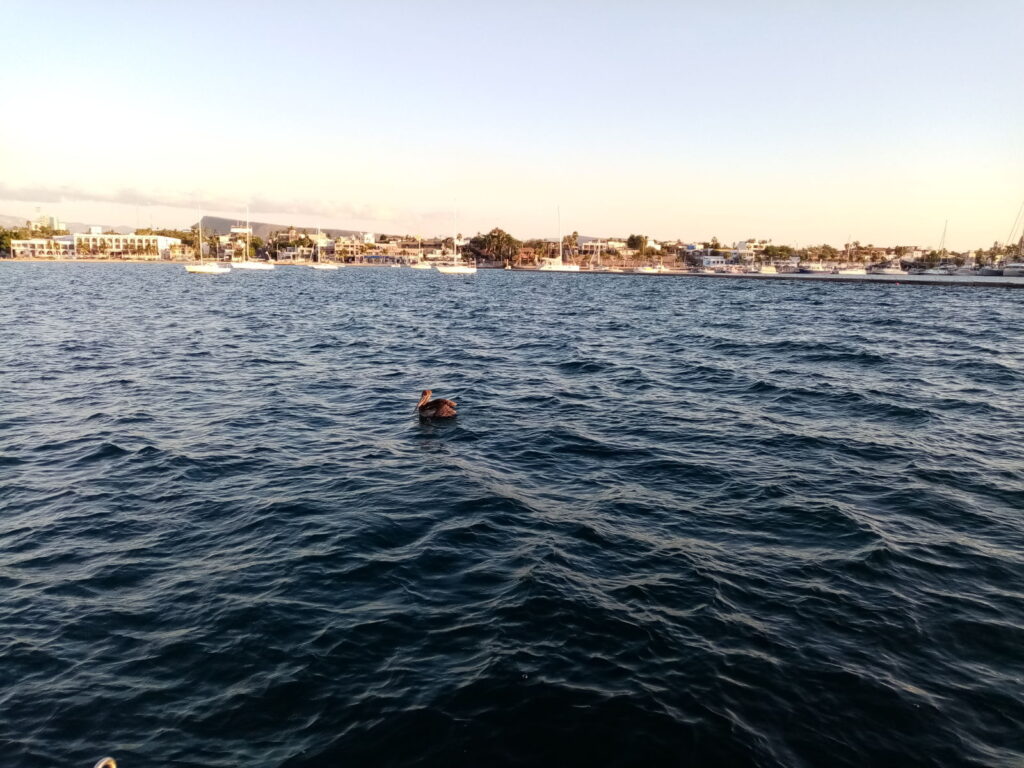
We had a great meal in the Bismarkcito Restaurant on the far end of the Malecon. Arturo kindly explained to the waiter that I was vegan and they prepared a delicious salad for me. We bade farewell to Arturo, who will be joining us for the Christmas period when we return to La Paz after a further venture into The Sea of Cortez.
Kathy

Lovely read Kath and stunning photos, it looks really beautiful there. If it wasn’t for the present situation I would be tempted to get on a plane and join you. Stay safe love b xxx